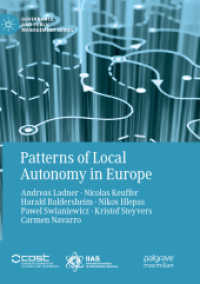- ホーム
- > 洋書
- > 英文書
- > Science / Mathematics
Full Description
Catalytic Air Pollution Control: Commercial Technology is the primary source for commercial catalytic air pollution control technology, offering engineers a comprehensive account of all modern catalytic technology. This Third Edition covers all the new advances in technology in automotive catalyst control technology, diesel engine catalyst control technology, small engine catalyst control technology, and alternate sustainable fuels for auto and diesel.
Contents
Preface xiii
Acknowledgments xvii
Acknowledgments, First Edition xix
Acknowledgments, Second Edition xxi
I Fundamentals 1
1. Catalyst Fundamentals 3
1.1 Introduction 3
1.2 Catalyzed Versus Noncatalyzed Reactions 3
1.3 Catalytic Components 13
1.4 Selectivity 14
1.5 Promoters and their Effect on Activity and Selectivity 15
1.6 Dispersed Model for Catalytic Component on Carrier: Pt on Al2O3 16
1.7 Chemical and Physical Steps in Heterogeneous Catalysis 18
1.8 Practical Significance of Knowing the Rate-Limiting Step 21
References 22
Questions 23
2. The Preparation of Catalytic Materials: Carriers, Active Components, and Monolithic Substrates 24
2.1 Introduction 24
2.2 Carriers 24
2.3 Making the Finished Catalyst 30
2.4 Nomenclature for Dispersed Catalysts 32
2.5 Monolithic Materials as Catalyst Substrates 32
2.6 Preparing Monolithic Catalysts 36
2.7 Catalytic Monoliths 37
2.8 Catalyzed Monolith Nomenclature 38
2.9 Precious Metal Recovery from Monolithic Catalysts 38
References 38
Questions 40
3. Catalyst Characterization 41
3.1 Introduction 41
3.2 Physical Properties of Catalysts 42
3.3 Chemical and Physical Morphology Structures of Catalytic Materials 48
3.4 Techniques for Fundamental Studies 60
References 61
Questions 62
4. Monolithic Reactors for Environmental Catalysis 63
4.1 Introduction 63
4.2 Chemical Kinetic Control 63
4.3 The Arrhenius Equation and Reaction Parameters 66
4.4 Bulk Mass Transfer 69
4.5 Reactor Bed Pressure Drop 74
4.6 Summary 76
References 76
Questions 77
5. Catalyst Deactivation 79
5.1 Introduction 79
5.2 Thermally Induced Deactivation 79
5.3 Poisoning 88
5.4 Washcoat Loss 94
5.5 General Comments on Deactivation Diagnostics in Monolithic Catalysts for Environmental Applications 95
References 97
Questions 98
II Mobile Source 101
6. Automotive Catalyst 103
6.1 Emissions and Regulations 103
6.2 The Catalytic Reactions for Pollution Abatement 106
6.3 The Physical Structure of the Catalytic Converter 107
6.4 First-Generation Converters: Oxidation Catalyst (1976-1979) 114
6.5 NOx, Co and HC Reduction: the Second Generation: The Three-Way Catalyst (1979-1986) 118
6.6 Vehicle Test Procedures (U.S., European, and Japanese) 123
6.7 NOx, Co, and HC Reduction: the Third Generation (1986-1992) 128
6.8 Palladium TWC Catalyst: The Fourth Generation (Mid-1990s) 136
6.9 Low-Emission Catalyst Technologies 138
6.10 Modern TWC Technologies for the 2000s 146
6.11 Toward a Zero-Emission Stoichiometric Spark-Ignited Vehicle 148
6.12 Engineered Catalyst Design 153
6.13 Lean-Burn Spark-Ignited Gasoline Engine 157
References 163
Questions 174
7. Automotive Substrates 176
7.1 Introduction to Ceramic Substrates 176
7.2 Requirements for Substrates 178
7.3 Design/Sizing of Substrates 180
7.4 Physical Properties of Substrates 185
7.5 Physical Durability 194
7.6 Advances in Substrates 207
7.7 Commercial Applications 222
7.8 Summary 229
References 230
Questions 236
8. Diesel Engine Emissions 238
8.1 Introduction 238
8.2 Worldwide Diesel Emission Standards 241
8.3 NOx-Particulate Trade-Off 245
8.4 Analytical Procedures for Particulates 245
8.5 Particulate Removal 246
8.6 NOx Reduction Technologies 263
8.7 2007 Commercial System Designs (PM Removal Only) 272
8.8 2010 Commercial System Approaches under Development (PM and NOx Removal) 275
8.9 Retrofit and Off-Highway 281
8.10 Natural Gas Engines 282
References 283
Questions 292
9. Diesel Catalyst Supports and Particulate Filters 295
9.1 Introduction 295
9.2 Health Effects of Diesel Particulate Emissions 298
9.3 Diesel Oxidation Catalyst Supports 298
9.4 Design/Sizing of a Diesel Particulate Filter 302
9.5 Regeneration Techniques 313
9.6 Physical Properties and Durability 319
9.7 Advances in Diesel Filters 324
9.8 Applications 340
9.9 Summary 350
References 352
Questions 355
10. Ozone Abatement within Jet Aircraft 357
10.1 Introduction 357
10.2 Ozone Abatement 358
10.3 Deactivation 363
10.4 Analysis of In-Flight Samples 365
10.5 New Technology 371
References 372
Questions 373
III Stationary Sources 375
11. Volatile Organic Compounds 377
11.1 Introduction 377
11.2 Catalytic Incineration 379
11.3 Halogenated Hydrocarbons 383
11.4 Food Processing 390
11.5 Wood Stoves 392
11.6 Process Design 394
11.7 Deactivation 394
11.8 Regeneration of Deactivated Catalysts 395
References 399
Questions 401
12. Reduction of No X 403
12.1 Introduction 403
12.2 Nonselective Catalytic Reduction of NOx 404
12.3 Selective Catalytic Reduction of NOx 407
12.4 Commercial Experience 417
12.5 Nitrous Oxide (N2O) 427
12.6 Catalytically Supported Thermal Combustion 429
References 434
Questions 439
13. Carbon Monoxide and Hydrocarbon Abatement from Gas Turbines 440
13.1 Introduction 440
13.2 Catalyst for CO Abatement 441
13.3 Non-Methane Hydrocarbon (NMHC) Removal 443
13.4 Oxidation of Reactive Hydrocarbons 444
13.5 Oxidation of Unreactive Light Paraffins 445
13.6 Catalyst Deactivation 447
References 448
Questions 449
14. Small Engines 450
14.1 Introduction 450
14.2 Emissions 450
14.3 EPA Regulations 451
14.4 Catalyst for Handheld and Nonhandheld Engines 455
14.5 Catalyst Durability 463
References 464
Questions 466
IV New and Emerging Technologies 467
15. Ambient Air Cleanup 469
15.1 Introduction 469
15.2 Premair® Catalyst Systems 470
15.3 Other Approaches 478
References 479
Questions 481
16. Fuel Cells and Hydrogen Generation 482
16.1 Introduction 482
16.2 Low-Temperature PEM Fuel Cell Technology 488
16.3 The Ideal Hydrogen Economy 495
16.4 Conventional Hydrogen Generation 496
16.5 Hydrogen Generation from Natural Gas for PEM Fuel Cells 499
16.6 Other Fuel Cell Systems 505
References 511
Questions 517
Index 518








